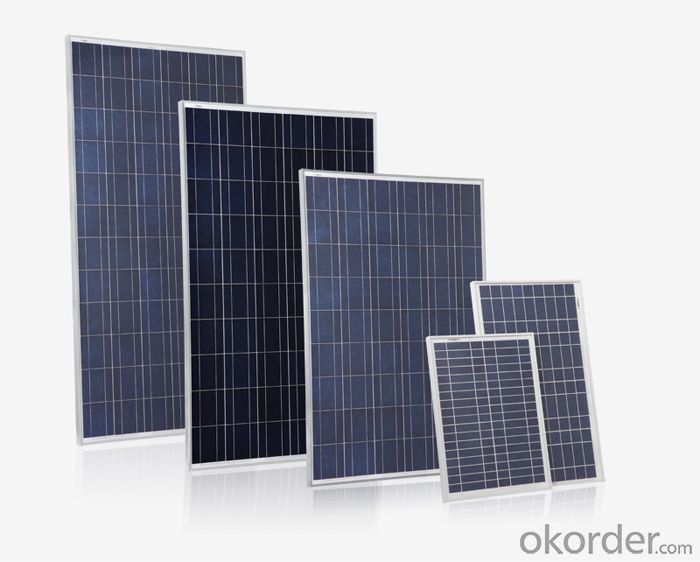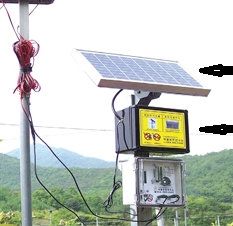Newest Polycrystalline solar Panel with Factory Price CNBM
- Loading Port:
- Qingdao
- Payment Terms:
- TT OR LC
- Min Order Qty:
- 10 set
- Supply Capability:
- 300000 set/month
OKorder Service Pledge
OKorder Financial Service
You Might Also Like
Polycrystalline Solar Modules
CNBM offers a range of small, medium and large polycrystalline solar modules, designed for a range of requirements.


Specifications:
Tolerance | +/-3% |
Cell | Polycrystalline silicon solar cells (156 x 156mm) |
N0. of Cells | 60 (0 x 6) |
Dimension of Modules (mm) | 1650 x 990 x 40 |
Weight (kg) | 25.5 |
Limits:
Operating Temperature | -40~+85? |
Storage Temperature | -40~+85? |
Maximum System Voltage | 1000 VDC max. |
Hail Impact | Diameter of 28mm with impact speed |
Temperature and Coefficients:
NOCT | 48C+/-2? |
Voltage temperature coefficient (%/K) | -0.35 |
Current temperature coefficient (%/K) | 0.05 |
Power temperature coefficient (%/K) | -0.45 |
Characteristics:
Model: | SGM-200P | SGM-210P | SGM-220P |
Max-power voltage Vmp (V) | 29.2 | 29.4 | 29.41 |
Max-power current Imp (A) | 6.85 | 7.14 | 7.48 |
Open-circuit voltage Voc (V) | 36.5 | 36.69 | 36.9 |
Short-Circuit Current Isc (A) | 7.28 | 7.6 | 7.93 |
Max-power Pm(W) | 200 | 210 | 220 |
Model: | SGM-230P |
Max-power voltage Vmp (V) | 29.8 |
Max-power current Imp (A) | 7.72 |
Open-circuit voltage Voc (V) | 37.31 |
Short-Circuit Current Isc (A) | 8.19 |
Max-power Pm(W) | 230 |
STC: Irradiance 1000W/m2, module temperature 25?, AM-=1.5
Poly Crystalline Solar Panels Specifications Range
Maximum Power (Pm) | Dimension | Weight | Operating Voltage (Vmp) | Operating Current (Imp) | Open Circuit Voltage (Voc) | Short Circuit Current (Isc) |
0.45W | 140x80x10mm | 0.08kg | 3.3V | 150mA | 4.6V | 160mA |
1.0W | 162x140x10mm | 0.16kg | 7.5V | 150mA | 10.3V | 160mA |
4.5W | 269x251x23mm | 0.8kg | 16.5V | 0.27A | 20.5V | 0.3A |
10W | 420.1×268.9×22.6mm | 1.92kg | 17.5V | 0.58A | 20.5V | 0.6A |
20W | 425x502x50mm | 3.0kg | 16.8V | 1.19A | 21.0V | 1.29A |
30W | 593x502x22.6mm | 3.9kg | 16.8V | 1.78A | 21.0V | 1.94A |
40W | 655x537x50mm | 5.75kg | 17.3V | 2.31A | 22.1V | 2.54A |
50W | 839x537x50mm | 6.0kg | 17.5V | 2.9A | 21.8V | 3.17A |
65W | 1111x502x50mm | 7.2kg | 17.6V | 3.69A | 22.1V | 3.99A |
80W | 1204x537x50mm | 7.7kg | 17.6V | 4.55A | 22.1V | 4.8A |
- Q:Can solar cells be used for powering streetlights?
- Yes, solar cells can be used for powering streetlights. Solar-powered streetlights use photovoltaic panels to convert sunlight into electricity, which is then stored in batteries for use during the night. This sustainable and renewable energy source eliminates the need for traditional grid electricity, reducing costs and environmental impact.
- Q:What is the role of solar cells in powering off-grid cabins?
- The role of solar cells in powering off-grid cabins is to harness energy from the sun and convert it into electricity. These cells, also known as photovoltaic cells, absorb sunlight and generate a direct current (DC), which is then converted into alternating current (AC) through an inverter. This AC power is used to operate appliances, lighting, and other electrical devices in off-grid cabins, providing a sustainable and renewable source of energy without the need for a traditional power grid connection.
- Q:Can anybody tell me how to make a solar cell at home?
- First of all, you need to be sure what you want to do with the solar cell. Do you want to generate electricity or hot water?
- Q:How do solar cells perform in dry desert conditions?
- Solar cells perform exceptionally well in dry desert conditions. The intense sunlight and lack of humidity in desert environments create optimal conditions for the generation of solar energy. The absence of clouds and minimal air pollution allows solar cells to efficiently convert sunlight into electricity, resulting in higher energy output. Additionally, the heat in desert regions can increase the efficiency of solar cells, as their performance typically improves with higher temperatures. Therefore, solar cells are highly effective and efficient in dry desert conditions.
- Q:What is the impact of saltwater exposure on solar cell efficiency?
- Saltwater exposure can have a significant negative impact on solar cell efficiency. The saltwater can corrode the metal components of the solar cells, leading to a decrease in their performance and overall efficiency. Additionally, the saltwater can create a conductive pathway that can bypass the solar cells, resulting in a loss of electrical energy. Therefore, it is crucial to protect solar cells from saltwater exposure to maintain their efficiency and prolong their lifespan.
- Q:What is the impact of solar cells on reducing energy waste?
- Solar cells have a significant impact on reducing energy waste by harnessing the sun's energy and converting it into electricity. By utilizing renewable and clean energy sources, solar cells contribute to reducing the dependence on fossil fuels, which are finite and contribute to environmental pollution. Additionally, solar cells help decrease energy waste by generating electricity at the point of use, minimizing transmission and distribution losses.
- Q:Can solar cells power an entire house?
- Yes, solar cells have the potential to power an entire house. With advancements in technology and proper installation of solar panels, it is possible to generate enough electricity to meet the energy needs of a household. However, the feasibility of this depends on various factors such as the size of the solar panel system, the energy consumption of the house, and the availability of sunlight in the area.
- Q:Can solar cells be used in powering irrigation systems?
- Yes, solar cells can be used to power irrigation systems. Solar energy can be converted into electrical energy by solar cells, which can then be used to power irrigation pumps and other components of the system. This makes solar-powered irrigation systems a sustainable and environmentally friendly alternative to traditional methods of powering irrigation systems.
- Q:How do solar cells perform in regions with high levels of salt spray and corrosive environments?
- Solar cells generally do not perform well in regions with high levels of salt spray and corrosive environments. The salt particles can accumulate on the surface of the solar cells, leading to reduced efficiency and decreased performance. Additionally, the corrosive nature of the environment can cause damage to the materials and components of the solar cells, further impacting their functionality. To mitigate these issues, special protective coatings or materials can be used to enhance the durability and resistance of solar cells in such regions.
- Q:What is the size and weight of a typical solar cell?
- The size and weight of a typical solar cell can vary depending on its intended application and technology. However, a standard silicon-based solar cell is typically square-shaped with dimensions ranging from a few centimeters to around 15 centimeters on each side. In terms of weight, most solar cells are quite lightweight, typically weighing between a few grams to around 100 grams, depending on the size and material used.
1. Manufacturer Overview |
|
|---|---|
| Location | |
| Year Established | |
| Annual Output Value | |
| Main Markets | |
| Company Certifications | |
2. Manufacturer Certificates |
|
|---|---|
| a) Certification Name | |
| Range | |
| Reference | |
| Validity Period | |
3. Manufacturer Capability |
|
|---|---|
| a)Trade Capacity | |
| Nearest Port | |
| Export Percentage | |
| No.of Employees in Trade Department | |
| Language Spoken: | |
| b)Factory Information | |
| Factory Size: | |
| No. of Production Lines | |
| Contract Manufacturing | |
| Product Price Range | |
Send your message to us
Newest Polycrystalline solar Panel with Factory Price CNBM
- Loading Port:
- Qingdao
- Payment Terms:
- TT OR LC
- Min Order Qty:
- 10 set
- Supply Capability:
- 300000 set/month
OKorder Service Pledge
OKorder Financial Service
Similar products
New products
Hot products
Related keywords



























